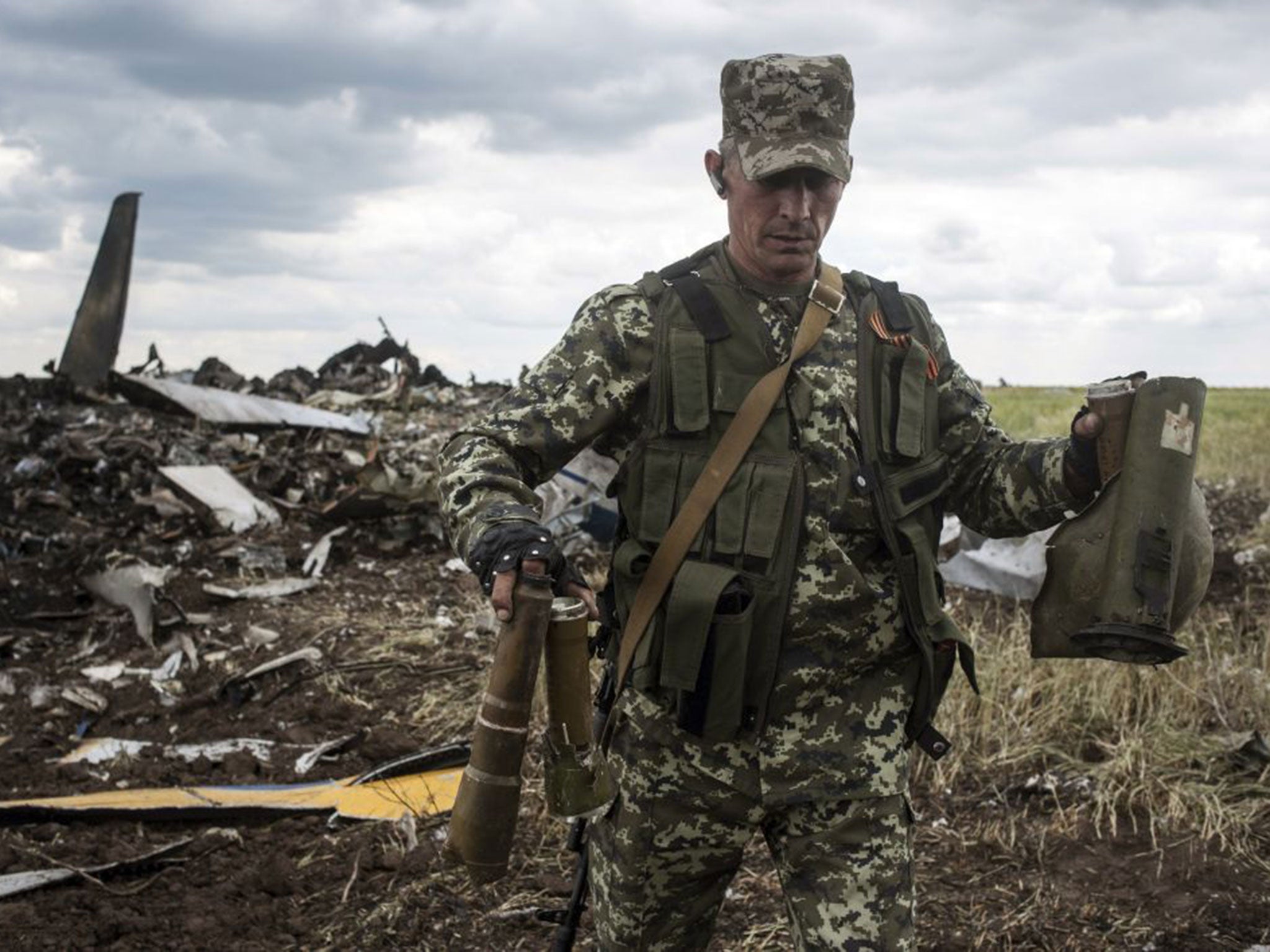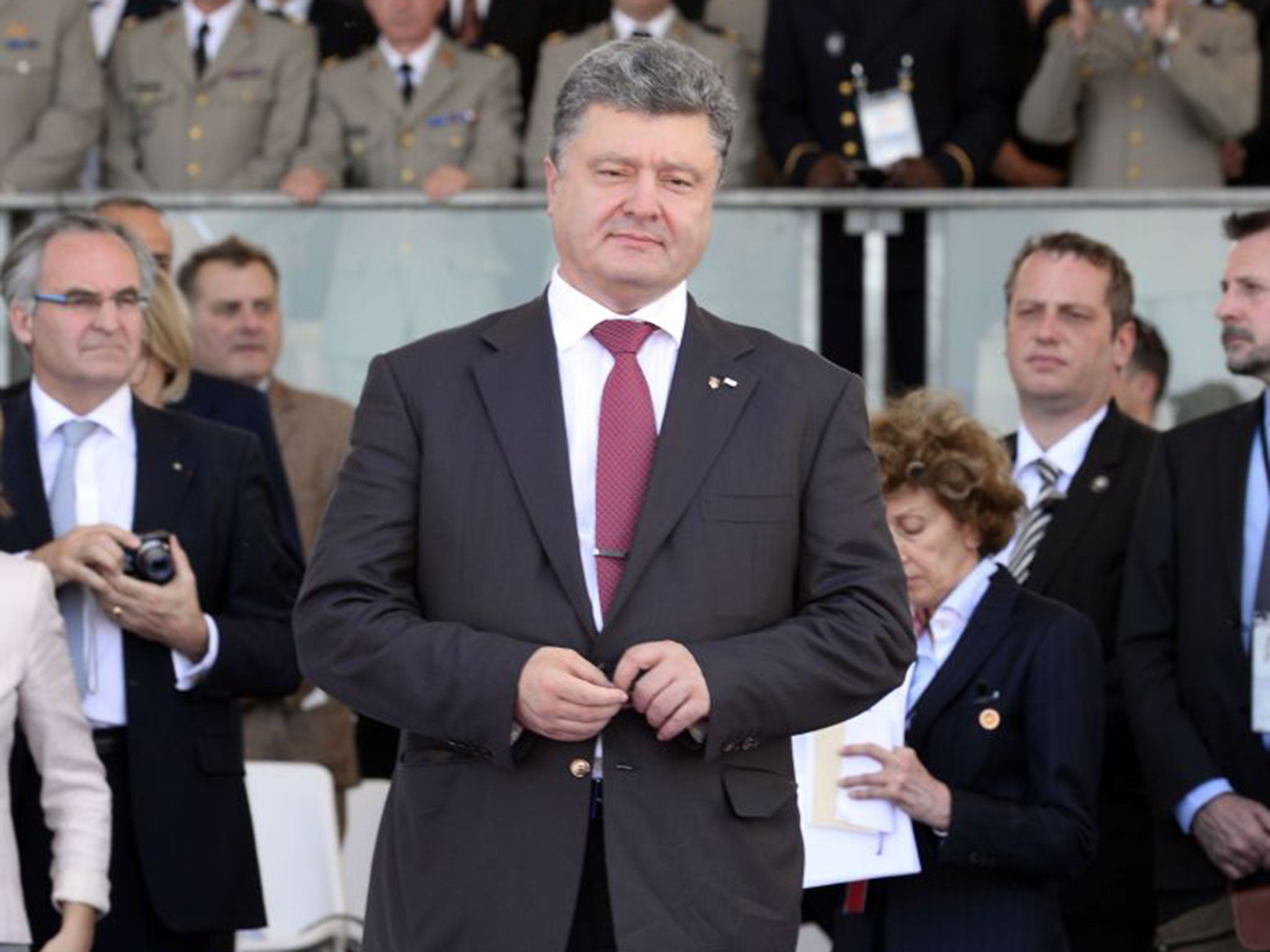Ukraine crisis: Kiev pledges to punish 'terrorism' that threatens the stability of the nation
New Poroshenko government promises to hit back after shooting down of military aircraft which killed all 49 on board

The shooting down of a military transport plane in Ukraine yesterday, killing all 49 people on board, prompted threats of a renewed government offensive on pro-Russian separatists in the country’s violent eastern regions.
President Petro Poroshenko has promised action against separatists who shot down the transport plane outside Luhansk, declaring they “must be punished” for their “acts of terrorism”. The aircraft had 40 paratroopers and nine crew on board.
But he also scolded the country’s security service, referring to “omissions” in measures to protect military aircraft from attack. This was the latest bloody episode in the struggle between the Ukrainian government and pro-Russian separatists in the east. Clashes between the two sides in recent weeks have left more than 270 people dead, according to government officials, as Kiev tries to crush an insurgency that threatens the stability of the nation.
President Poroshenko, who was sworn in as Ukraine’s new leader last weekend, summoned security chiefs yesterday for talks. He promised an “adequate” response to the incident. Military and defence ministry officials said the plane was hit by anti-aircraft missiles and machine-gun fire in the early hours of yesterday morning. Mr Poroshenko also pledged that today would be a day of mourning for those killed. The US Secretary of State, John Kerry, expressed his condolences to those who had died. A senior State Department official said Mr Kerry had called the Ukrainian Prime Minister, Arseny Yatseniuk ,and “underscored the commitment of the US and G7 partners to raise the costs for Russia if it does not end the flow of weapons across the border and break with separatists”.
The Ukrainian prosecutor general’s office said it had opened a criminal investigation into the incident under anti-terrorism laws. If the death toll is confirmed, it would mark the largest single loss of government troops since Kiev’s “anti-terror” operation began in April.
Parts of the tail section of the plane and other elements of scorched wreckage were scattered across a field near the village of Novohannivka, about 12 miles south of Luhansk. The aircraft was said to have been coming into land at the city’s airport when it was shot out of the sky. The airport has been under the control of government troops, despite much of the rest of the city being held by the separatists.
“All those involved in cynical acts of terrorism of this magnitude must be punished,” Mr Poroshenko said. His statement came as reports suggested that a bomb containing grenades and metal nuts had been found outside the President’s headquarters overnight on Friday.

The military campaign has become a protracted affair with skirmishes between separatists and government troops a daily occurrence across the eastern regions. The latest bloodletting came a week after Mr Poroshenko used his inaugural address to speak of a peace deal – aimed at calming the tensions that threaten to tear Ukraine apart. He said during his address that the fighting must end “this week”.
On Friday, Ukrainian troops launched an offensive to take back Mariupol, a key port which has changed hands between the insurgents and government troops several times in the past two months. There have also been recent clashes in Luhansk and Slovyansk.
Separatists previously launched assaults on Luhansk airport, as well as military outposts, with some success. Slovyansk has had a number of pitched battles, with fighting sometimes going on for hours. It was also where separatists shot down a military helicopter, killing 12 troops.
The possible use of heavy artillery by the separatists has again raised questions about Russia’s role in the unrest. It was a suspension of a potential trade deal with the European Union, which would have pushed Ukraine further from Russian influence, that sparked protests and the fall of the country’s previous president, Viktor Yanukovych.
Western nations, along with the government in Kiev, have long held the view that the Kremlin has helped to stir the unrest with the intention of ensuring Russian influence over its neighbour. On Friday night, the US State Department claimed that Russia had sent heavy weaponry into Ukraine, after Arsen Avakov, the Ukrainian Interior Minister, claimed that three tanks had entered the Luhansk region from Russia. The insurgents claim the tanks came from a Ukrainian military stockpile.
“We assess that separatists in eastern Ukraine have acquired heavy weapons and military equipment from Russia, including Russian tanks and multiple rocket launchers,” Marie Harf, a State Department spokeswoman, said in a statement. Ms Harf also told a briefing that a convoy of three T-64 tanks, several BM-21 rocket launchers and other military vehicles had crossed from Russia into Ukraine in recent days. Russia denies this.
But Nato released satellite images yesterday that, it said, raised serious questions about Russia’s actions. One image, dated 30 May, showed a Russian unit deployed near the southern Russian city of Rostov-on-Don as part of a build-up of tens of thousands of troops close to Ukraine’s border, but no tanks were present, Nato said. Another image, from 6 June, showed the Russian unit had left as part of a broader withdrawal from the border area. But while other vehicles had pulled out, the image showed that eight main battle tanks had arrived.
The movements raised “questions concerning Russia’s role in facilitating instability in eastern Ukraine and its involvement in the movement of military equipment from Russian territory into Ukraine”, said Nato, adding the tanks had no markings or camouflage paint like those used by the Ukrainian military. “In fact, they do not have markings at all, which is reminiscent of tactics used by Russian elements involved in destabilising Crimea.”
The Kremlin has said that it is committed to finding a peaceful solution to the crisis in Ukraine and, as a goodwill gesture, talks were set for last night aimed at solving a gas-pricing dispute between the two nations before a deadline to cut off supplies to Kiev, which falls tomorrow.
“We condemn the shooting down of the Ukrainian military plane and continue to be deeply concerned about the situation in eastern Ukraine, including by the fact that militant and separatist groups have received heavy weapons from Russia, including tanks,” said Laura Lucas Magnuson, a White House spokeswoman.

Join our commenting forum
Join thought-provoking conversations, follow other Independent readers and see their replies
Comments